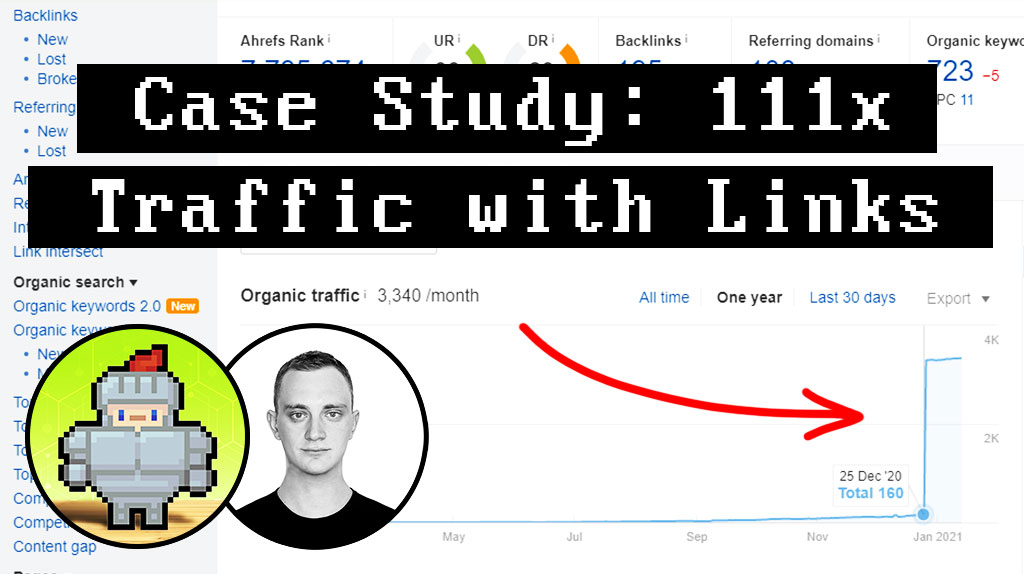Case Study: Recovering From Bad Links
Join the 1,000+ brands that trust us for their link building.
It’s easy to waste thousands of dollars on low-quality link building that gets you nowhere.
While an extremely powerful tool for increasing your rankings and getting more website visitors from Google, link building can also cause issues when done incorrectly, even leading to ranking losses or an inability to get higher rankings.
But don’t worry if that’s you!
In this step-by-step case study, we’ll show you how we recovered a website with a large amount of low-quality backlinks and increased its monthly visitors by over 10x.
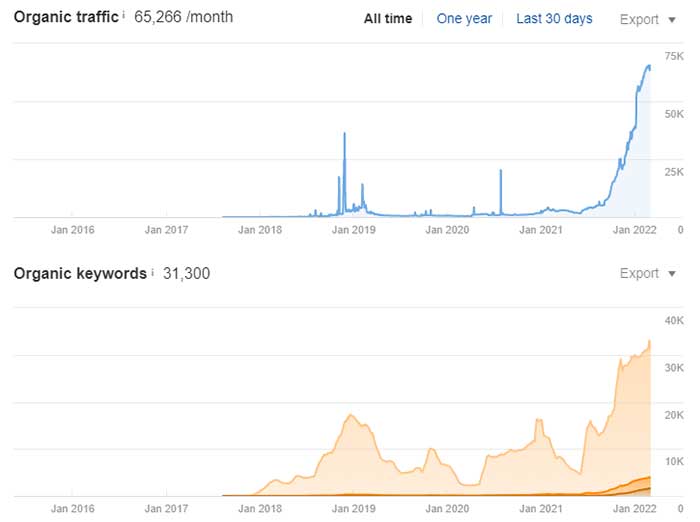
What We’ll Talk About In This Case Study:
Analyzing A Backlink Profile And A Site’s Health
Bad Backlinks Vs. Quality Links
Link Building Strategy and Execution
Recovering From Past Link Building Mistakes
What We Won’t Talk About (Much):
On-page SEO
Technical SEO
Keyword Research or Content Strategy
Monetization, CRO, etc.
About The Website
Like in my previous case study, we are not the owners of this site.
The owner is a client who enrolled in our Managed Link Building Program. This is a done-for-you link building service where you give us your goals and monthly budget, and then we build backlinks for you each month to help your Google rankings.
This means that we were not involved with anything other than link building, and the rest of the SEO equation was taken care of by the site’s owner.
The website is in the video games niche, and they are using the old (but very effective) strategy of ranking for less competitive keywords first and then shifting to more difficult keywords after establishing more trust and authority with Google.
They were having new content published to the website pretty regularly which we highly recommend doing alongside any link building. The number of new articles being added wasn’t anything crazy – probably around three to ten articles per month.
Here are what some of their top keywords look like now in Ahrefs today:
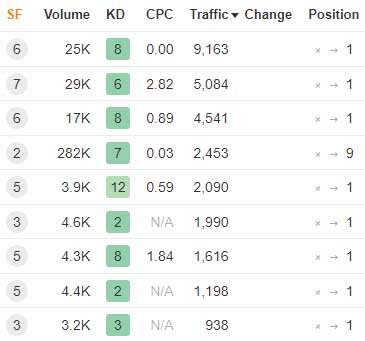
As you can see, the site is really starting to rank for all kinds of high volume terms!
Application and Our Analysis
Like all new sites in our Managed Link Building Program, the client first filled out an application.
Then, we analyzed its current off-page SEO and backlinks to develop a game plan.
In the application, they mentioned that the site took a beating in recent Google algorithm updates and also that the “black hat” tactics they were using before didn’t seem to be working too well anymore.
Here’s What Our Analysis Found:
- It was a pretty large site with about 2,000 URLs indexed on Google.
- It wasn’t brand new – it had a few years of age according to the links coming in.
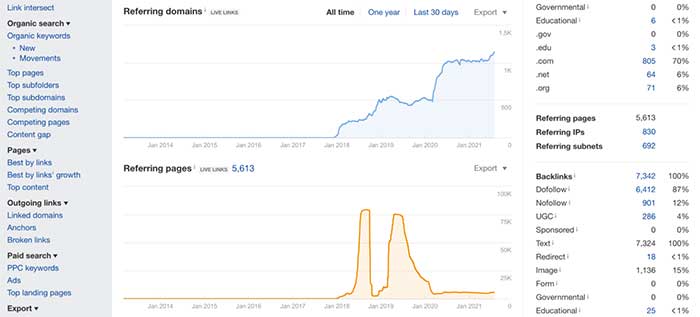
- It’s DR (domain rating) was 45 which seemed a little low given that the site had over 1,000 referring domains.

- The keywords and traffic had been pretty volatile over the years – constant ups and downs without any solid, steady growth.
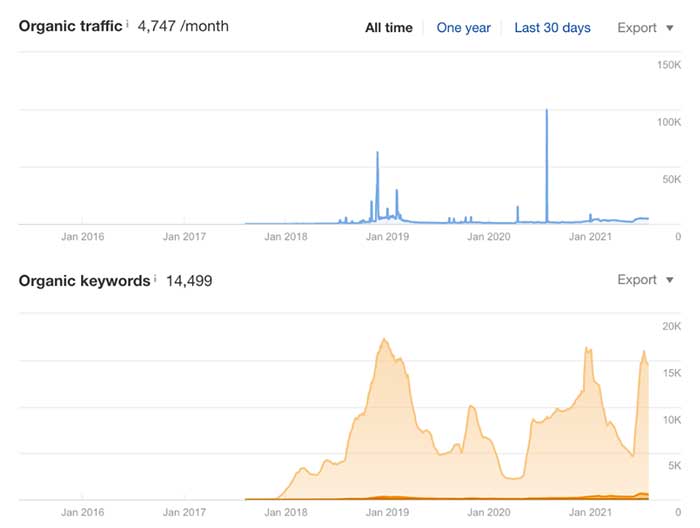
- Its backlink profile looked very unnatural – lots of very spammy web 2.0’s, foreign language links, auto-generated links, etc. Pretty much exactly what you think of when you think of a spammy, black-hat link profile.
- Despite the links looking bad, the anchor text used was decent but still a bit lacking in the natural department (branded, generic, and URL anchors).
- Even though the site didn’t seem very healthy, it was still ranking for a good amount of relevant keywords including some page 1 spots. It still had tons of room for growth.
- Its inner pages had a lot of links when compared to the overall amount of referring domains, and its homepage was pretty weak (low amount of links).
- The client’s budget was quite low considering the current RD of the site ($500/mo).
In the end, we thought the site was ranking pretty well considering how unnatural its backlink profile was.
It was also nice to see that Google understood the website quite well – it was being allowed to rank for relevant terms.
Everything we saw pointed to its low-quality backlink profile being the source of volatility and inability to grow steadily.
Our Proposed Link Building Strategy
With our analysis in mind, we developed the following strategy to help the site recover from its bad backlinks and get things moving in the right direction:
1. We would focus on contextual backlinks from real sites/articles in their niche.
This means no more of the spammy, low-quality stuff they were using before. A healthy mix of niche edits and guest posts from solid websites would be the main tools used.
2. We’d use a mix of authority levels.
Their link profile and anchor text needed to be diversified so that it looked more natural. For this reason, we’d be using a decent amount of lower authority links in the beginning as we needed to build a higher number of them.
Higher authority links would be used when possible.
3. We’d focus primarily on the homepage as it was weak on links and the inner-pages were already a bit heavy.
When the site began to react positively, we would slowly shift towards using more inner-page links. But for now, it would be the homepage only.
4. We’d focus on adding more natural anchor text – branded, URL, and generic anchors.
Like above, we would switch to using more money anchors after things started to look healthier (steady growth in keywords and traffic).
5. We would re-analyze the site at the beginning of each month to see if modifications to our strategy were required.
Our style of link building is fluid, and we let Google tell us how they currently feel about a website to inform our link building strategy.
Why We Didn’t Recommend A Disavow
Submitting a list of bad backlinks to Google to disavow is one way of getting rid of them.
It tells Google to ignore them completely.
However, we only recommend disavows as an absolute last resort when your traffic and rankings look something like this:
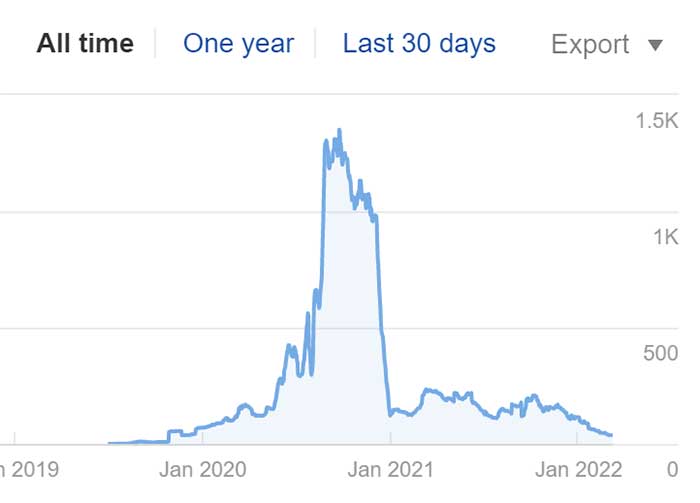
And even then, you need to be absolutely sure the backlinks were the cause of the problem (which obviously is not very easy to do).
For the website in this picture, I’m 99% sure the site’s backlinks are actually NOT the problem, but it’s rather a combination of EAT and affiliate-specific issues.
Many times, people end up disavowing backlinks that were actually helping them.
That’s why our preferred strategy in most cases is to move forward with building new, quality backlinks instead of trying to get rid of the “bad” ones.
A Quick Note On Building Backlinks
Like with all sites enrolled in our MLB program, we re-analyzed the website’s current health and rankings at the beginning of each month before new orders were sent to our link building teams.
Some links take longer than others to build with things like niche edits and guest posts taking up to 3-4 weeks.
This in conjunction with the fact that link building takes time to show results means that, in most cases, we couldn’t see the full results of the previous month’s building when we started building links for the next month.
All of the links built to the site during this time were built by our teams, and you can learn more about each type of link and package we used on our specific product pages.
Link Building: Month 1
The first month of link building for the site was based on the analysis given during the application process we covered before.
The site already had a good amount of pillow links (directories, citations, blog comments, etc), so we didn’t think we needed to add any more at the moment.
We wanted to diversify away from the low-quality backlinks the site already had to more relevant, high-quality links while still pushing a decent level of authority.
The link building budget for the first month was $500. Here was the order:


Niche edits and guest posts were both used during this month.
In general, these 2 types of links make up about 95% of the budget for any link building project as they are links on real sites/articles within the target site’s niche, they are relevant, and they move the needle.
We used low to mid-authority links for this order because we wanted to build a higher number of links in order to diversify away from his old, low-quality backlinks.
We pointed all the links at the site’s homepage as it was relatively low on links with many inner pages potentially having too many.
We also like to build lots of homepage links when sites don’t look very healthy (like this one) with volatile traffic and keyword graphs and no steady growth.
As for the anchor text, we kept things very natural as well and stayed away from money anchors for the same reason: We only use natural anchors when a website doesn’t look healthy.
Link Building: Month 2
Here’s what we saw in Ahrefs before building links for the second month:
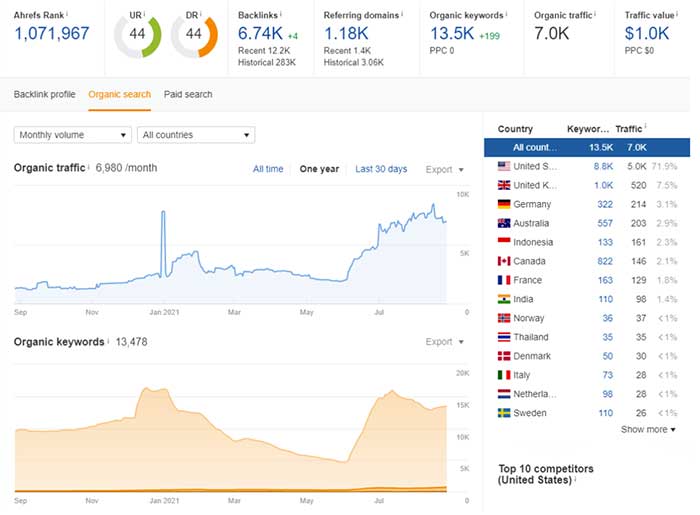
The website gained a little traffic and rankings while the number of keywords the site was ranking for actually decreased a bit.
We weren’t worried because it can often take a good amount of time for a site with a backlink profile as spammy as this one to level out and start growing steadily, and we were prepared to see this same thing for months.
Volatility usually does not stop the exact instant you start building good links.
Our new analysis of the site didn’t bring us to any different conclusions or strategies: We would continue diversifying the site’s backlink profile with quality links from real sites until we started seeing some steady growth.
The budget for the second month was $500. Here was the order:


We used a mix of guest posts and niche edits again – no change there.
We used even lower authority this round of building to speed up the diversification process. The more quality links we could build to help tip the scales the better.
In a perfect world, we’d do this with high authority links. But of course, not all budgets permit building a lot of high authority links as they are also quite a bit more expensive.
Again, we sent everything to the homepage as things were still volatile and his homepage was still pretty lacking in links.
And lastly, we used a mix of branded, URL, and generic (miscellaneous terms like “click here”) anchor text for the same reasons as before.
Link Building: Month 3
Here’s what we saw in Ahrefs when we went to analyze the site after month two:
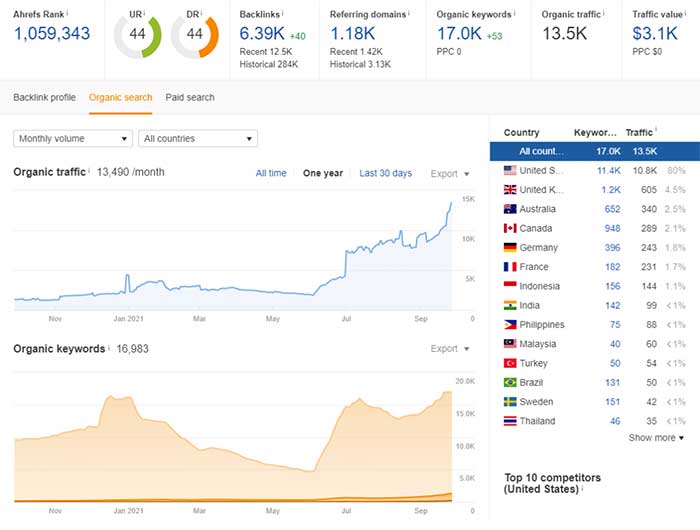
Annnnd we have liftoff.
That’s about a 100% gain in traffic in 1 month, and keyword growth also turned back around and went back to previous levels.
This was a very good thing to see, and we honestly did not expect it to come so soon.
This is where a lot of SEOs screw things up.
They think, “Things are turning around and looking really good, so I can start hitting more inner pages with backlinks and with exact match anchor text again!”
Wrong.
The site is still considered volatile. Keep up the natural building, or you just risk perpetuating the cycle of ups and downs.
The backlink budget for month three was $500. Here was the order:


Surprise, surprise! We used another mix of niche edits and guest posts for month three.
It’s worth noting that you don’t need to use a mix like this every month. You could alternate months building edits one month and guest posts the next, for example.
We also built some social signals (links from social media) to help simulate buzz on social media to help validate the link building campaign and for things to look nice and natural.
We used higher authority overall than in previous months as things were starting to move and we didn’t necessarily want to keep building low authority links if we didn’t have to.
We sent everything to the homepage yet again as we still considered the site volatile and possibly unhealthy. We wanted this trend to continue for some time before doing otherwise.
And lastly, we used very natural anchor text again as well.
Note that we had built no inner-page links and used no exact-match anchors throughout this entire process so far.
Link Building: Month 4
Who said link building had to be hard?
Here were the results from month three of building only homepage links with natural anchors:
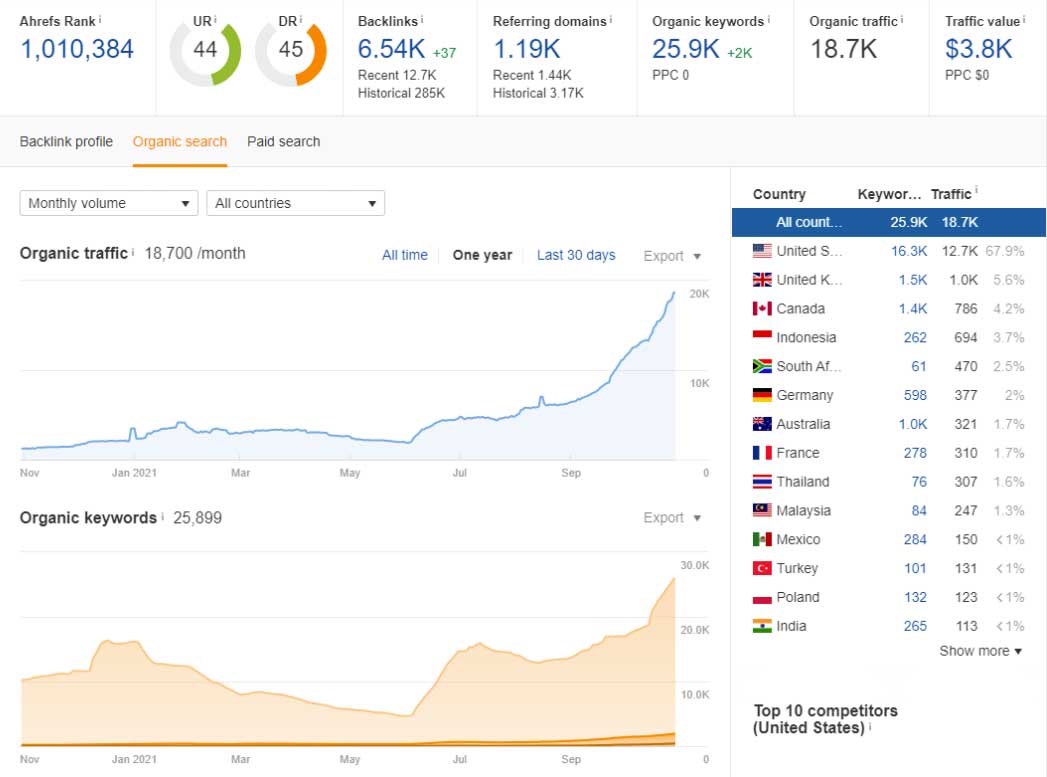
Traffic was now up about 200% from when we started building, and keywords were up about 100% from the initial dip.
The site was really starting to look great.
At this point, we would consider slowly shifting towards using more inner-page links with some exact-match anchors every now and then (the keyword here being “slowly”).
But we didn’t. Here’s why:
1. The site’s inner-pages were still very heavy on backlinks and the homepage was still weak on backlinks overall.
2. You could still consider the site volatile. It had only been a couple months of growth at this point.
3. Why would we stop doing something that’s getting such good results and is considered extremely safe? If it ain’t broke, don’t fix it!
The budget for links for the fourth month was $500. Here’s what we built:


Again, we built a mix of niche edits and guest posts. We decreased the authority on the niche edits this month in order to build more guest posts.
We could have built only guest posts this month as the campaign thus far had been more niche-edits heavy, and we like to balance the two.
We sent all the links to the homepage again, and we only used natural anchors again.
It’s nice when our job is easy.
Link Building: Month 5 And Beyond
Here’s what we saw at the beginning of month five:
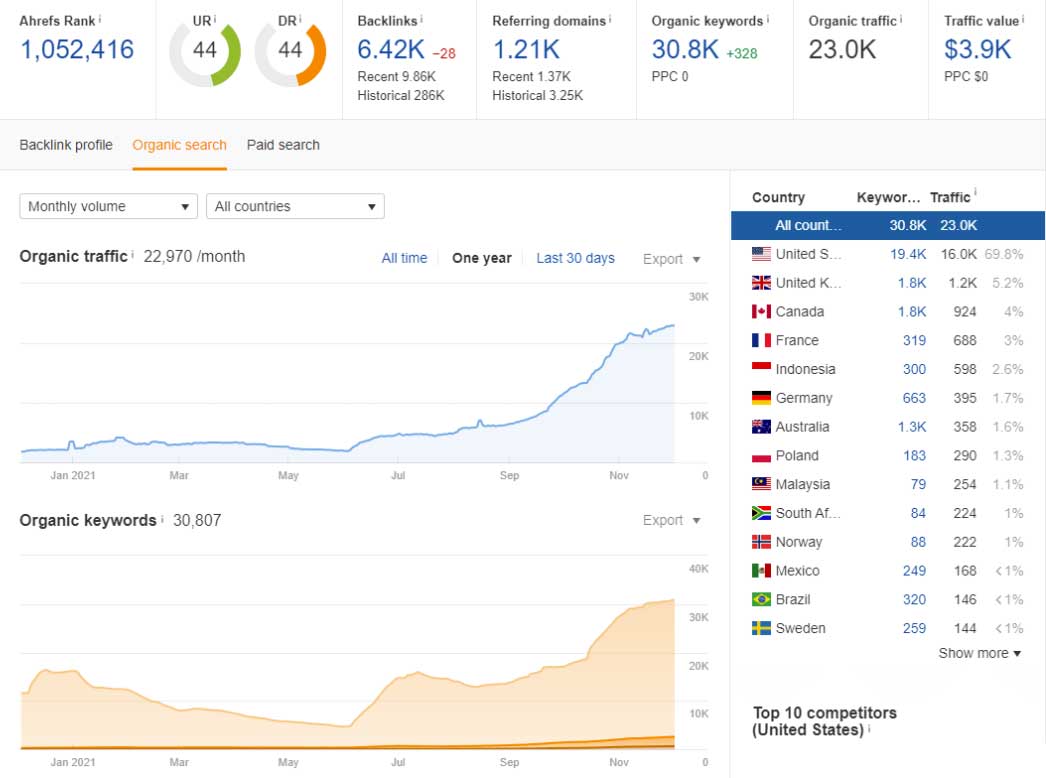
Traffic and keywords were still continuing to grow, however, the pace had definitely slowed down.
This is where we would normally start to slowly build more inner-page links and use some exact-match anchors, however, both would still be in low amounts.
The homepage would still be our primary target for this particular site, though, because of how many links the inner pages already had.
At this point, you’re probably thinking, “How many more months of homepage links are you going to torture me with?”
None. Let’s fast forward a bit. Here’s how things look now:
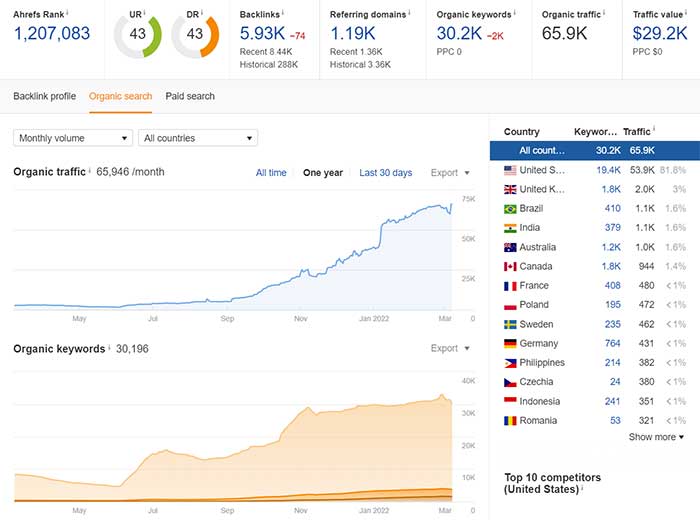
That’s a traffic growth of about 10 times since we first started working on the site.
Pretty nice for only building homepage links with natural anchors… wouldn’t you agree?
Takeaways From This Case Study
First and foremost, we’ve learned you are willing to sit through an entire case study telling you to do the same thing repeatedly – homepage links with natural anchors.
Kudos to you!
This is the backbone of the strategy we use every time we first start working on a site that looks volatile and unhealthy. It’s extremely easy to execute, it’s safe, and it works.
Here are the key points for you again:
1. Linking to your homepage is extremely important.
Even more so if your site isn’t doing too well and has a very unnatural backlink profile. When in doubt, linking to your homepage is always good. Natural sites get homepage links, and so should you.
2. Branded, URL, generic, and topical anchors keep things natural.
You don’t need to try to squeeze as much juice as possible out of every single link with exact match or partial match anchors, especially when you aren’t getting the results you want. Google loves to see these types of anchors.
3. Fast recoveries from bad links are great but not the norm.
Yeah, this site recovered fast as hell. But like mentioned before, we didn’t expect it to, and most sites don’t recover at this same speed. Manage your expectations and keep moving forward with a process you know works.
4. Diversification is key.
The goal here is to build enough backlinks so that there are more good backlinks and more natural anchors text than bad backlinks and manipulative anchor text. Low authority links are more cost-effective, but you should try to use as high of authority links as you can afford to do it with.
5. Content is king?
Jokes aside, the truth is that this link building campaign would most likely not get the same results if the site owner wasn’t doing proper keyword research, optimizing their on-page SEO correctly, and publishing new content regularly. Backlinks without this stuff is like pouring jet fuel into a beat-up 1989 Honda Civic.
6. Disavows are a last resort.
You should be absolutely sure that your bad backlink profile is the cause of your issues (and you are experiencing major losses in traffic and rankings) before disavowing in order to make sure you aren’t losing any links that could potentially help you.
We see issues like this more often than you can imagine. Don’t sweat it.
Keep calm, trust the process, and carry on.
Be sure to check out our other link building case studies for more actionable tips that get real results!
Questions? Ask below or join us at the SEO Round Table!
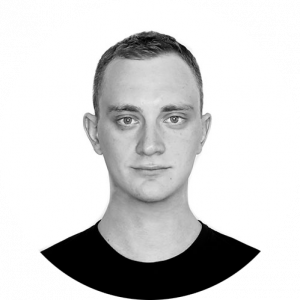 Article by:
Article by:
Chris Tzitzis
Hey I'm Chris, one of the founders here at SirLinksalot. I'm into building internet money machines (affiliate websites) and specialize in building backlinks. Find out more about me and my link building team.
 Questions or Comments?
Questions or Comments?
We are active in our Facebook Group seven days a week and would love to hear from you. Ask us questions, learn from other group members, and share your knowledge.
Related Posts
No Results Found
The page you requested could not be found. Try refining your search, or use the navigation above to locate the post.
Ready To Start Building Your Rankings?
Your link building journey to the top of Google starts today!
Apply for Managed Link Building to get a free analysis and game plan, or order backlinks a la carte.
Link building services that work.

